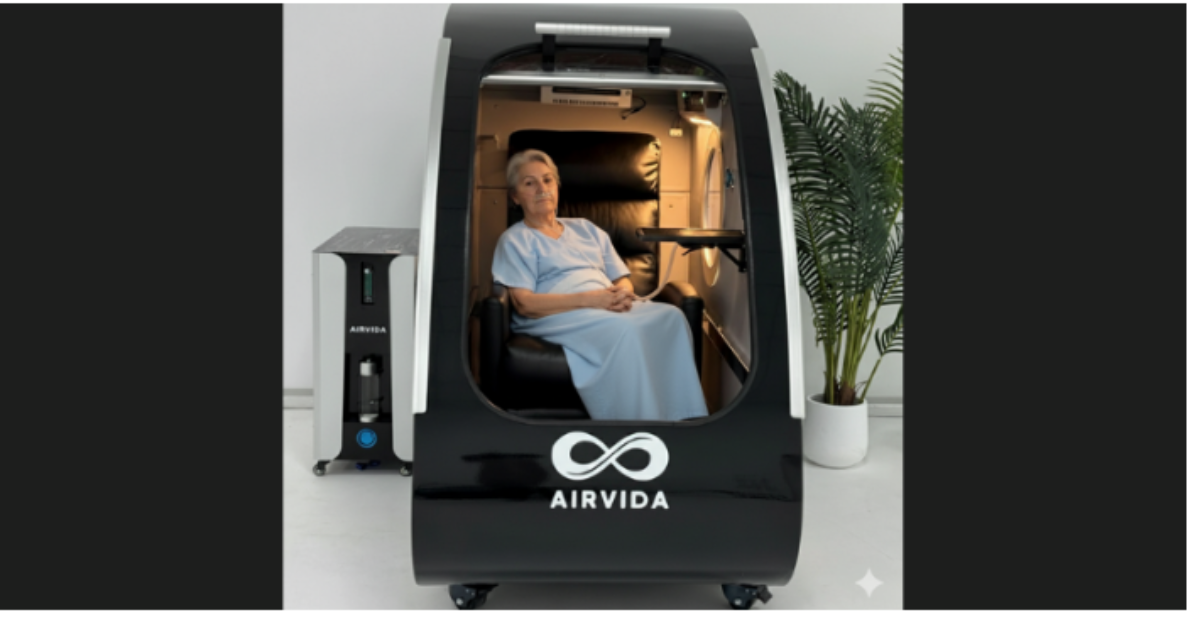Can a hyperbaric chamber for stroke patients really help with recovery? The short answer is yes, many people experience better oxygen circulation, reduced inflammation, and faster healing after using hyperbaric oxygen therapy (HBOT).
This comprehensive guide explains how hyperbaric oxygen therapy (HBOT) works, why it plays an important role in supporting stroke recovery, and which chamber types or models are best suited for both home-based users and professional rehabilitation environments seeking safe, effective, and science-backed oxygen therapy solutions.
What Is a Hyperbaric Chamber and How Does It Work
A hyperbaric chamber is a pressurized, sealed environment where you breathe 100% pure oxygen at levels higher than normal atmospheric pressure. This increased oxygen absorption enhances cellular metabolism, accelerates tissue regeneration, promotes faster wound healing, and supports recovery from conditions linked to inflammation, low oxygen supply, or neurological damage.
During HBOT sessions, oxygen dissolves directly into your blood plasma, dramatically increasing its availability to body tissues. This process allows oxygen to reach areas with limited circulation, such as damaged or inflamed brain tissue after a stroke, helping stimulate repair, reduce inflammation, and enhance the body’s overall healing response naturally and effectively.
For those interested in starting therapy at home, explore the Hyperbaric Chamber Collection in Fort Lauderdale to find suitable options
Why It Matters for Stroke Patients
When a stroke occurs, areas of the brain are deprived of oxygen, causing damage to nerve cells and impairing function. HBOT helps restore oxygen supply to these affected regions, supporting tissue recovery, reducing inflammation, and stimulating the brain’s ability to reorganize and form new neural connections for improved long-term function.

How HBOT Aids Stroke Recovery
Hyperbaric Oxygen Therapy (HBOT) plays a promising role in stroke rehabilitation by enhancing oxygen delivery to the brain, reducing inflammation, and supporting neural repair. This section explains how HBOT promotes recovery, boosts neuroplasticity, and helps stroke survivors regain function and overall well-being.
1. Restoring Brain Oxygen Levels
Hyperbaric oxygen therapy (HBOT) significantly increases oxygen delivery to the brain, promoting cell regeneration and reducing post-stroke swelling. This enhanced oxygenation revitalizes affected areas, supports energy metabolism, and assists the body’s natural healing mechanisms, helping stroke patients recover critical functions and minimize further neurological damage.
2. Enhancing Neuroplasticity
Neuroplasticity, the brain’s capacity to reorganize and form new neural pathways, is vital for stroke recovery. HBOT boosts oxygen availability, which stimulates dormant neurons and encourages reconnection between brain regions. As a result, many patients report noticeable improvements in movement, coordination, memory, speech, and overall cognitive performance following consistent therapy sessions.
3. Supporting Long-Term Healing
Regular HBOT sessions promote long-term brain recovery by reducing inflammation, improving circulation, and stimulating tissue repair. The oxygen-enriched environment enhances mitochondrial activity, which fuels cellular regeneration. Over time, stroke survivors often experience better balance, clearer thinking, and increased physical endurance, contributing to sustained neurological and physical rehabilitation progress.

Why Choose a Hyperbaric Chamber for Stroke Patients
If you’re searching for a natural, non-invasive approach to enhance post-stroke recovery, a hyperbaric chamber for stroke patients provides a safe and supportive environment that promotes healing from within. By increasing oxygen flow, HBOT complements conventional rehabilitation methods and helps accelerate physical, cognitive, and neurological recovery over time.
|
Treatment Type |
Focus |
Invasiveness |
Oxygen Support |
|
Physical Therapy |
Mobility & muscle strength |
Non-invasive |
Low |
|
Medication |
Manage symptoms |
Moderate |
None |
|
Hyperbaric Therapy |
Cellular repair & oxygenation |
Non-invasive |
High |
Compared to traditional treatments, HBOT offers a non-invasive, drug-free alternative that leverages your body’s own repair mechanisms. Instead of relying on chemicals or surgical intervention, it enhances natural healing by improving oxygen flow, reducing inflammation, and accelerating tissue regeneration, promoting recovery safely and effectively for both medical and wellness applications alike.
Choosing the Right Hyperbaric Chamber for Home or Clinic Use
When selecting a chamber, it’s important to consider comfort, pressure level, and available space. Here’s a comparison of two popular options:
|
Chamber Type |
Best For |
Key Features |
|
Soft-Shell Chamber |
Home users, mild therapy |
Portable, easy setup, lower pressure (1.3–1.5 ATA) |
|
Hard-Shell Chamber |
Clinical or advanced recovery |
Higher pressure (up to 3.0 ATA), faster oxygen delivery |
For larger or shared spaces, explore the Large Hyperbaric Chamber Collection for spacious, comfortable designs.
If you’re planning to begin a long-term therapy routine, consider investing in a model from the Buy Hyperbaric Chamber Collection to ensure consistent access and cost savings over time.
How to Use a Hyperbaric Chamber Safely
Using a hyperbaric chamber safely ensures effective results and minimizes potential risks. This section outlines essential safety tips, preparation steps, and best practices to help users maximize the benefits of HBOT while maintaining comfort and preventing common issues during therapy sessions.
-
Consult your physician first. They’ll assess if HBOT is suitable based on your stroke type and overall health.
-
Start with shorter sessions. Most patients begin with 30–60 minute treatments at lower pressure and increase gradually.
-
Stay hydrated. Drinking water before and after sessions helps your body adapt to oxygen changes.
-
Keep consistency. Regular use provides the best long-term results. Most programs include 20–40 sessions.
Practical Tips for Better Results
Maximizing your results from hyperbaric oxygen therapy requires consistency, preparation, and mindful habits. In this section, you’ll find practical tips to help you enhance each HBOT session’s effectiveness, support faster recovery, and ensure a safe, comfortable, and rewarding overall experience.
-
Avoid caffeine before treatment to prevent dehydration.
-
Wear loose, breathable clothing during your session.
-
Track your progress, many users notice improved alertness and coordination within weeks.
-
Pair HBOT with a balanced diet rich in omega-3s and antioxidants to enhance recovery.
You can also explore real-world patient experiences and measurable recovery improvements in What Is the Success Rate of Hyperbaric Treatment. This resource offers valuable insights into HBOT outcomes, showing how consistent oxygen therapy may contribute to better healing rates, neurological recovery, and overall quality of life enhancements.
Common Side Effects and Safety Notes
HBOT is generally safe, but mild side effects like ear pressure or fatigue can occur. Equalize your ears by swallowing or yawning during the session. Always follow professional guidelines for pressure limits and treatment duration.
Some people wonder, does hyperbaric oxygen therapy age you? In reality, it’s quite the opposite. As explained in Does a Hyperbaric Chamber Age You?, HBOT promotes cellular repair, boosts collagen production, and improves circulation, helping rejuvenate skin, slow oxidative stress, and support natural anti-aging processes at the tissue and cellular level.
Final Takeaway: Hyperbaric Chamber for Stroke Patients
Using a hyperbaric chamber for stroke patients can play a meaningful role in recovery. It helps restore brain oxygen, supports neuroplasticity, and enhances long-term healing, all without invasive procedures.
For stroke survivors aiming to regain mobility, mental clarity, and independence, hyperbaric oxygen therapy (HBOT) offers a safe, scientifically supported method to encourage natural recovery. By enhancing oxygen delivery to the brain, HBOT may help reduce inflammation, support tissue repair, and promote overall improvements in neurological function and daily quality of life.
Frequently Asked Questions
What is the treatment for a stroke patient?
The treatment for a stroke patient often combines medications, physical therapy, and, in some cases, hyperbaric oxygen therapy. The goal is to restore blood flow, minimize damage, and improve brain recovery. HBOT enhances oxygen supply to damaged cells, which helps repair tissue faster and supports better functional outcomes.
What are good signs of stroke recovery?
Good signs of stroke recovery include regaining strength, improved speech, better coordination, and increased alertness. Emotional stability and independence in daily activities also indicate progress. Many patients report gradual improvements after consistent therapy, especially when combining HBOT with rehabilitation exercises.
Is hyperbaric oxygen therapy good for stroke patients?
Yes, hyperbaric oxygen therapy is good for stroke patients because it increases oxygen delivery to the brain, supports neuroplasticity, and helps reduce inflammation. This leads to improved movement, focus, and mental clarity. Many patients experience noticeable benefits within a few weeks of consistent use.
Who should avoid hyperbaric oxygen therapy?
People with untreated pneumothorax (collapsed lung), certain lung conditions, or ear infections should avoid hyperbaric oxygen therapy until cleared by a medical professional. Those taking specific medications or with heart concerns should always consult a doctor before starting HBOT to ensure it’s safe and effective for their condition.




